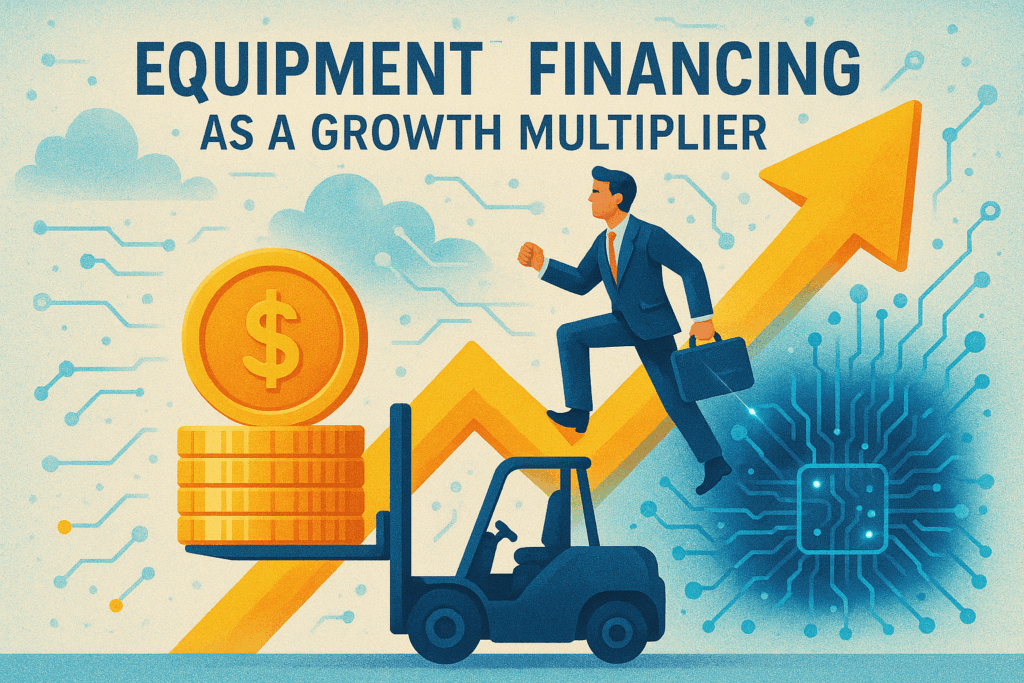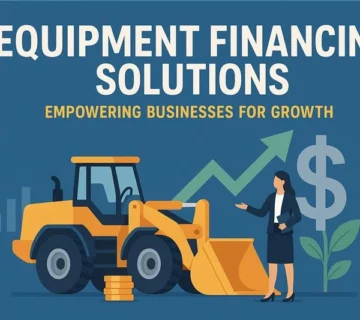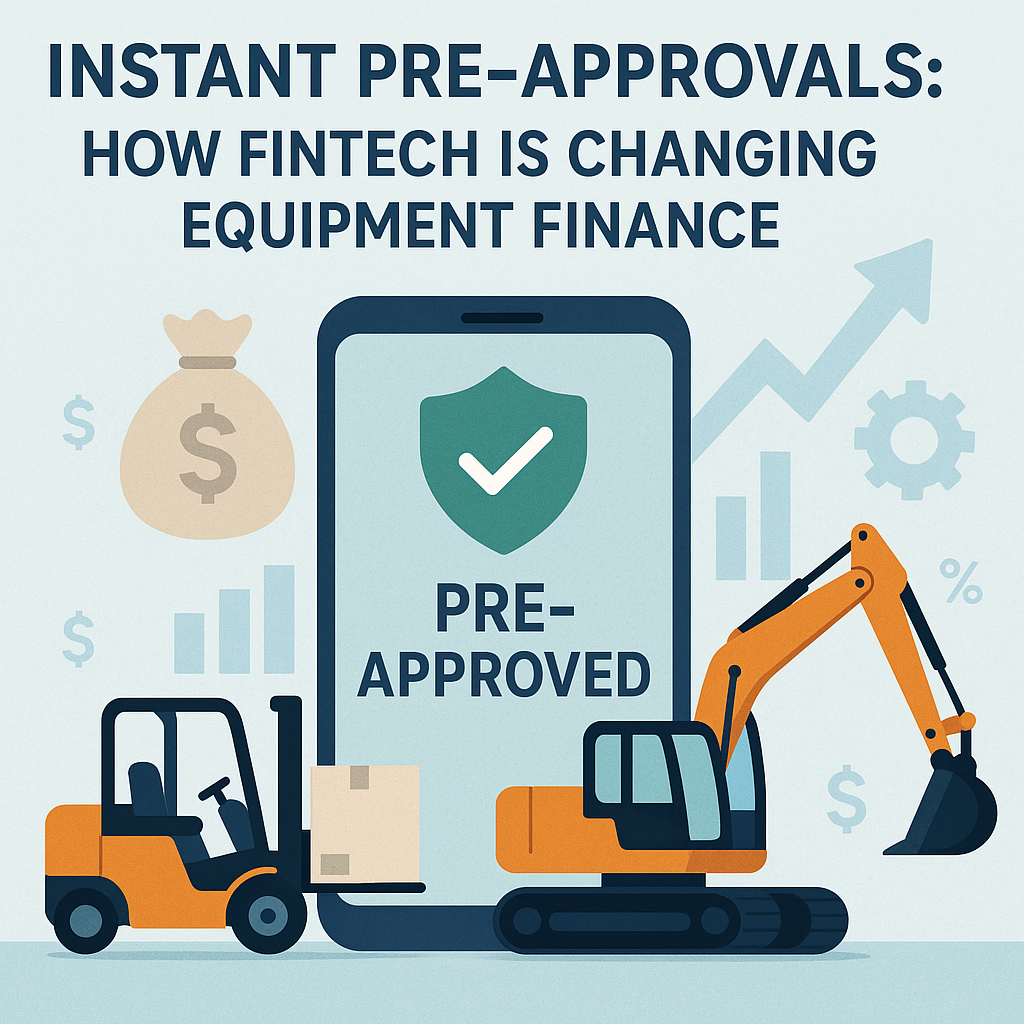How to Use Equipment Financing as a Growth Multiplier: A Strategic Business Guide
Equipment financing represents one of the most underutilized yet powerful tools for business expansion. When executed strategically, it transforms from a simple funding mechanism into a growth multiplier that can accelerate your company’s trajectory while preserving working capital and maintaining operational flexibility.
What is Equipment Financing and Why It Matters
Definition and Core Concepts
Equipment financing involves securing funding specifically for business equipment purchases, where the equipment itself serves as collateral. This financing method offers several key advantages:
- Collateral-based security – Lower risk for lenders means better rates for borrowers
- Preserved credit lines – Maintains other borrowing capacity for operational needs
- Direct investment correlation – Equipment directly impacts revenue generation
- Flexible terms – Various structures to match business cash flow patterns
The Strategic Advantage
The fundamental principle behind using equipment financing as a growth multiplier lies in leveraging the productive capacity of new equipment to generate returns that exceed the cost of financing. This approach allows businesses to:
- Expand operations without depleting cash reserves
- Increase efficiency through modern technology
- Capture market opportunities that require specific equipment
- Build competitive advantages through superior capabilities
Understanding the Growth Multiplier Effect
How the Multiplier Works
The growth multiplier effect occurs when equipment financing enables revenue increases that compound over time. Here’s how it typically unfolds:
Phase 1: Initial Investment
- Equipment acquisition through financing
- Installation and staff training
- Initial productivity improvements
Phase 2: Revenue Generation
- Increased production capacity or service delivery
- New market opportunities become accessible
- Cost efficiencies reduce operational expenses
Phase 3: Compounding Returns
- Enhanced reputation leads to more customers
- Improved cash flow enables additional investments
- Market positioning strengthens competitive advantage
Real-World Example
Consider a manufacturing startup that finances new production equipment costing $100,000:
- Equipment increases production capacity by 40%
- Generates additional $180,000 in annual revenue
- Creates $50,000 in annual cost savings through efficiency
- Total annual benefit: $230,000 vs. $24,000 financing cost
Strategic Equipment Selection for Maximum Growth Impact
Revenue-Generating Equipment Categories
Manufacturing Equipment
- Production machinery that increases output capacity
- Quality control systems that reduce defects
- Automated systems that improve consistency
Technology Infrastructure
- Servers and computing equipment for tech startup equipment financing
- Software platforms that enhance service delivery
- Digital tools that improve customer experience
Transportation Assets
- Delivery vehicles that expand service areas
- Specialized transport equipment for unique requirements
- Fleet management systems that optimize operations
Equipment Evaluation Framework
When selecting equipment for financing, use this systematic approach:
- Revenue Impact Assessment
- Direct revenue generation potential
- Market expansion opportunities
- Customer capacity improvements
- Efficiency Analysis
- Labor cost reductions
- Time savings quantification
- Quality improvement benefits
- Competitive Advantage Evaluation
- Unique capability development
- Market differentiation potential
- Barrier creation for competitors
Financial Structuring Strategies for Optimal Growth
Financing Structure Options
Traditional Equipment Loans
- Fixed monthly payments
- Equipment ownership upon completion
- Potential for early payoff
Equipment Leasing Arrangements
- Lower monthly payments
- Upgrade flexibility
- Maintenance packages often included
Lease-to-Own Programs
- Combines leasing flexibility with ownership benefits
- Popular among equipment financing for startups
- Allows for equipment testing before full commitment
Payment Structure Optimization
Standard Payment Plans
- Fixed monthly amounts throughout term
- Predictable cash flow impact
- Suitable for stable revenue businesses
Graduated Payment Schedules
- Lower initial payments that increase over time
- Ideal for startup equipment financing scenarios
- Allows growth to support higher payments
Seasonal Payment Arrangements
- Payments aligned with business cycles
- Higher payments during peak seasons
- Lower payments during slow periods
Finding the Right Financing Partner
Characteristics of Best Equipment Financing Companies
Traditional Lenders
- Banks and credit unions
- Established relationships and competitive rates
- Comprehensive service offerings
Specialized Equipment Financiers
- Industry-specific expertise
- Fast equipment financing approval processes
- Flexible terms and structures
Alternative Lending Platforms
- Digital equipment financing platform solutions
- Easy equipment financing application processes
- Tech enabled equipment finance capabilities
Evaluation Criteria for Lenders
- Speed and Efficiency
- Application processing time
- Approval timeline
- Funding speed
- Terms and Flexibility
- Interest rate competitiveness
- Payment structure options
- Early payoff provisions
- Industry Expertise
- Understanding of your business type
- Equipment knowledge
- Risk assessment accuracy
Specialized Considerations for Startups
Equipment Financing Companies for Startups
Startups face unique challenges in equipment financing, including:
Limited Credit History
- Personal guarantees often required
- Higher interest rates initially
- Alternative documentation needs
Cash Flow Constraints
- Seasonal payment structures beneficial
- Lower down payment options important
- Flexible terms during growth phases
Growth Uncertainty
- Equipment versatility becomes crucial
- Upgrade options add value
- Lease arrangements provide flexibility
Equipment Leasing for Startups Benefits
Lower Initial Investment
- Reduced upfront costs preserve working capital
- Equipment finance for startups with limited resources
- Easier qualification requirements
Flexibility and Upgrades
- Technology refresh capabilities
- Capacity scaling options
- Market testing opportunities
Tax Advantages
- Lease payments as operating expenses
- Equipment financing tax benefits optimization
- Improved cash flow management
Debunking Common Myths of Equipment Financing
Myth 1: “Equipment Financing is Too Expensive”
Reality: When properly structured, equipment financing often costs less than the opportunity cost of delayed growth. The revenue generation from financed equipment typically exceeds financing costs by substantial margins.
Myth 2: “Only Established Companies Qualify”
Reality: Many lenders specialize in startup equipment financing and offer programs specifically designed for newer businesses. The equipment serves as collateral, reducing lender risk.
Myth 3: “Cash Purchase is Always Better”
Reality: Cash purchases tie up working capital that could be used for other growth initiatives. Equipment financing preserves liquidity while enabling growth.
Myth 4: “Application Processes are Complex and Slow”
Reality: Modern digital equipment financing platforms have streamlined applications, with many approvals happening within 24-48 hours for qualified applicants.
Technology-Driven Equipment Financing Solutions
Digital Equipment Financing Platform Advantages
Streamlined Applications
- Online application processes
- Document upload capabilities
- Real-time status tracking
Faster Decision Making
- Automated underwriting systems
- AI-powered risk assessment
- Quick approval notifications
Enhanced Customer Experience
- 24/7 application access
- Mobile-friendly interfaces
- Transparent fee structures
Tech Enabled Equipment Finance Features
Advanced Analytics
- Equipment performance monitoring
- ROI tracking and reporting
- Predictive maintenance insights
Integration Capabilities
- Accounting software connections
- ERP system compatibility
- Financial reporting automation
Flexible Management Tools
- Payment scheduling options
- Early payoff calculators
- Upgrade pathway planning
Maximizing Tax Benefits
Equipment Financing Tax Benefits Overview
Depreciation Deductions
- Section 179 immediate expensing
- Bonus depreciation opportunities
- Modified Accelerated Cost Recovery System (MACRS)
Interest Expense Deductions
- Financing interest as business expense
- Reduced taxable income
- Improved cash flow through tax savings
Lease Payment Benefits
- Operating lease payments fully deductible
- Reduced tax liability
- Enhanced cash flow management
Tax Strategy Optimization
- Timing Considerations
- Year-end equipment purchases for immediate deductions
- Quarterly payment planning
- Multi-year tax planning strategies
- Structure Selection
- Purchase vs. lease tax implications
- Depreciation method optimization
- Interest deduction maximization
- Professional Consultation
- CPA involvement in planning
- Tax law compliance assurance
- Strategy refinement over time
Implementation Timeline and Best Practices
Phase 1: Planning and Preparation (Weeks 1-2)
Equipment Research
- Market analysis and vendor comparison
- Specification development
- Cost-benefit analysis completion
Financial Planning
- Cash flow projection development
- Financing structure evaluation
- Lender research and selection
Phase 2: Application and Approval (Weeks 3-4)
Documentation Preparation
- Financial statements compilation
- Business plan updates
- Equipment quotes gathering
Application Submission
- Multiple lender applications
- Term negotiation
- Final structure agreement
Phase 3: Implementation and Optimization (Weeks 5-8)
Equipment Acquisition
- Purchase order processing
- Delivery coordination
- Installation planning
Performance Monitoring
- Baseline measurement establishment
- ROI tracking system implementation
- Continuous improvement planning
Risk Management and Mitigation Strategies
Common Risk Categories
Equipment Obsolescence
- Technology advancement impacts
- Market demand shifts
- Functional inadequacy development
Financial Performance Risks
- Revenue projections not meeting expectations
- Market conditions deteriorating
- Competition intensifying
Operational Challenges
- Equipment downtime impacts
- Maintenance cost increases
- Staff training requirements
Mitigation Approaches
- Diversification Strategy
- Multiple equipment investments
- Various vendor relationships
- Risk spreading across asset types
- Insurance and Protection
- Comprehensive equipment coverage
- Business interruption insurance
- Extended warranty considerations
- Performance Monitoring
- Regular ROI assessments
- Market condition tracking
- Adjustment strategy development
Measuring Success and Optimizing Performance
Key Performance Indicators (KPIs)
Financial Metrics
- Revenue increase attribution
- Cost reduction quantification
- ROI percentage achievement
- Cash flow improvement measurement
Operational Metrics
- Production capacity utilization
- Efficiency improvement percentages
- Quality enhancement measurements
- Customer satisfaction improvements
Strategic Metrics
- Market share growth
- Competitive advantage development
- New opportunity creation
- Long-term value building
Continuous Optimization Process
Monthly Reviews
- Performance data analysis
- Issue identification and resolution
- Adjustment planning
Quarterly Assessments
- ROI calculation updates
- Market condition evaluation
- Strategy refinement
Annual Planning
- Equipment lifecycle assessment
- Future investment planning
- Strategy evolution development
Frequently Asked Questions
What types of businesses benefit most from equipment financing startup strategies?
Manufacturing companies, construction firms, transportation businesses, medical practices, and technology companies typically see the strongest growth multiplication effects from equipment financing. These industries rely heavily on specialized equipment that directly impacts revenue generation and operational efficiency. Service-based businesses can also benefit significantly when equipment enhances their ability to serve more clients or deliver higher-quality services.
Startup-specific benefits include:
- Lower initial capital requirements
- Preserved working capital for operations
- Access to modern, efficient equipment
- Competitive capability development
How do I calculate the potential return on investment for financed equipment?
Calculate ROI using this comprehensive approach:
Step 1: Calculate Total Investment
- Equipment cost + financing fees + installation costs
- Training and setup expenses
- First-year maintenance costs
Step 2: Project Revenue Impact
- Direct revenue increases from capacity expansion
- New market opportunities value
- Premium pricing capabilities
Step 3: Calculate Cost Savings
- Labor cost reductions
- Efficiency improvements
- Quality enhancement benefits
Step 4: Net Benefit Analysis
- Total benefits minus total costs
- Payback period calculation
- Long-term value assessment
A comprehensive ROI calculation should show positive returns within 12-24 months for most growth-focused equipment investments.
What financing terms provide the best growth multiplication potential for startup equipment financing?
Optimal financing terms for startups should balance several factors:
Payment Structure Recommendations:
- 15-20% of monthly cash flow allocated to equipment payments
- Graduated payment schedules starting lower
- Seasonal adjustments for revenue fluctuations
- Early payoff options without penalties
Term Length Considerations:
- 3-5 years for technology equipment
- 5-7 years for manufacturing equipment
- 7-10 years for real estate-related assets
Down Payment Strategy:
- 10-20% down payment when possible
- Zero-down options for cash preservation
- Trade-in value utilization
How can I find the most suitable equipment financing companies for startups?
Finding the right financing partner requires systematic evaluation:
Research Approach:
- Industry association recommendations
- Peer business referrals
- Online review and rating analysis
- Professional advisor suggestions
Evaluation Criteria:
- Startup experience and understanding
- Application speed and efficiency
- Flexible terms and structures
- Competitive rates and fees
- Customer service quality
Due Diligence Steps:
- Multiple quote comparisons
- Reference checking
- Contract term analysis
- Hidden fee identification
What are the key risks in using equipment financing for growth, and how can they be mitigated?
Primary Risk Categories:
Financial Risks:
- Equipment costs exceeding projected returns
- Market demand declining
- Competition reducing profit margins
Operational Risks:
- Equipment failure or downtime
- Technology obsolescence
- Staff training challenges
Mitigation Strategies:
- Comprehensive market research before investment
- Conservative ROI projections
- Diversified equipment portfolio
- Insurance coverage for key assets
- Regular performance monitoring
- Flexible financing terms allowing adjustments
How does easy equipment financing compare to traditional business loans?
Equipment Financing Advantages:
- Equipment serves as collateral, reducing risk
- Typically lower interest rates
- Faster approval processes
- Preserved credit lines for other needs
- Direct correlation between investment and returns
Traditional Loan Advantages:
- Flexibility in fund usage
- No collateral requirements (unsecured options)
- Potential for larger amounts
- Established banking relationships
Best Use Cases:
- Equipment financing for specific asset purchases
- Traditional loans for working capital or general business needs
- Combination strategies for comprehensive growth funding
What role does digital equipment financing platform technology play in modern equipment financing?
Digital Platform Benefits:
Application Efficiency:
- 24/7 application access
- Streamlined documentation upload
- Real-time status tracking
- Mobile-friendly interfaces
Decision Speed:
- Automated underwriting systems
- AI-powered risk assessment
- Same-day approval capabilities
- Instant quote generation
Management Tools:
- Online payment processing
- Account management dashboards
- Performance tracking capabilities
- Document storage and access
Integration Capabilities:
- Accounting software connections
- ERP system compatibility
- Banking platform integration
- Reporting tool connections
How should seasonal businesses approach fast equipment financing timing?
Strategic Timing Considerations:
Pre-Season Planning:
- Equipment research during slow periods
- Financing arrangement 60-90 days before peak season
- Installation and training completion before demand surge
Seasonal Payment Structures:
- Higher payments during peak revenue periods
- Reduced payments during slow seasons
- Deferred payment options for off-season months
Cash Flow Management:
- Revenue forecasting for payment planning
- Reserve fund establishment for payment security
- Multiple financing arrangements for different equipment needs
What documentation do lenders typically require for tech startup equipment financing?
Standard Documentation Requirements:
Financial Information:
- Business financial statements (if available)
- Personal financial statements of owners
- Tax returns (business and personal)
- Bank statements (3-6 months)
- Cash flow projections
Business Information:
- Business registration documents
- Business plan or executive summary
- Industry experience documentation
- Equipment specifications and quotes
Additional Startup Requirements:
- Personal guarantees from owners
- Collateral information
- References from vendors or customers
- Proof of down payment capability
How can I optimize equipment financing tax benefits for maximum advantage?
Tax Optimization Strategies:
Timing Strategies:
- Year-end equipment purchases for immediate deductions
- Section 179 expense election timing
- Bonus depreciation utilization
Structure Selection:
- Purchase vs. lease tax implications
- Depreciation method optimization (MACRS vs. straight-line)
- Interest deduction maximization
Professional Planning:
- CPA consultation for strategy development
- Tax law compliance assurance
- Multi-year planning for optimal benefits
Documentation Requirements:
- Proper record keeping for all transactions
- Equipment usage documentation
- Business purpose verification
What are the main myths of equipment financing that prevent businesses from using this growth strategy?
Common Myths and Realities:
Myth: “Only perfect credit qualifies” Reality: Many lenders work with startups and businesses with limited credit history, using equipment as collateral.
Myth: “Equipment financing is too expensive” Reality: Rates are often competitive with other business financing, and the revenue generation typically exceeds costs.
Myth: “Applications take too long” Reality: Modern digital platforms can provide approvals within 24-48 hours for qualified applicants.
Myth: “Cash purchase is always better” Reality: Financing preserves working capital and provides tax benefits that often make it more advantageous.
Myth: “Leasing means you never own the equipment” Reality: Many lease arrangements include purchase options or automatic ownership transfer.
How do I know when it’s time to expand my equipment finance for startups strategy?
Expansion Indicators:
Operational Signals:
- Current equipment at 80%+ capacity utilization
- Customer demand exceeding current capabilities
- Quality issues due to outdated equipment
- Competitor advantages from superior equipment
Financial Indicators:
- Consistent positive cash flow from existing equipment
- Clear ROI projections for additional investments
- Available financing capacity
- Tax benefits from additional depreciation
Market Signals:
- New market opportunities requiring specific equipment
- Industry technology advances creating competitive gaps
- Customer requirements evolving beyond current capabilities
- Seasonal demand patterns supporting additional capacity
Strategic Timing:
- Before peak demand periods
- During favorable financing market conditions
- When equipment prices are competitive
- After successful optimization of existing equipment





No comment